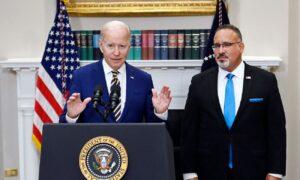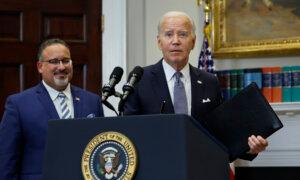The move comes as President Joe Biden’s latest attempt to offer large-scale student loan cancellation.
A total of $1.2 billion in federal student loan debt will be automatically discharged for 153,000 borrowers enrolled in President Joe Biden’s “most generous ever” repayment plan, the U.S. Department of Education said on Wednesday.
To be eligible for the latest round of student loan debt cancellation, the borrowers must be enrolled in the new income-driven repayment (IDR) plan, dubbed SAVE, have been making at least 10 years of payments, and have originally taken out $12,000 or less for college.
For every $1,000 borrowed above $12,000, a borrower can receive debt discharge after an additional year of payments. For example, those who had an original principal balance of $13,000 can now have their remaining balance wiped out if they’ve been in repayment for 11 years.
All borrowers on SAVE receive forgiveness after 20 or 25 years, depending on whether they have loans for graduate school.
“With today’s announcement, we are once again sending a clear message to borrowers who had low balances: if you’ve been paying for a decade, you’ve done your part, and you deserve relief,” U.S. Secretary of Education Miguel Cardona said in a statement, pledging that the “historic fight to cancel student debt isn’t over yet.”
The announcement comes as the Biden administration pushes for a second attempt at large-scale federal student loan debt cancellation after the nation’s highest court torpedoed his initial $400 billion plan last summer. After the court’s conservative majority ruled that he overstepped his authority, President Biden tasked the Education Department with crafting a new plan on a more solid legal basis, which in turn requires a more lengthy and complicated process called “negotiated rulemaking.”
According to the Education Department, it has so far canceled over $138 billion in federal student loan debt owed by more than 3.9 million borrowers. That includes $45.6 billion for 930,500 borrowers who are on an IDR plan, $56.7 billion for 793,000 borrowers who work in the public sector, 11.7 billion for 513,000 borrowers with a permanent disability, and $22.5 billion for 1.3 million borrowers who said they have been misled or defrauded by their schools.
The Biden administration also boasts about the 7.5 million-person enrollment of SAVE, which Mr. Cardona called the “most generous” his department ever offered to borrowers.
Like the previous IDR programs it seeks to replace, SAVE adjusts the monthly payment amount based on the borrower’s income and family size. According to the Education Department’s most up-to-date figure, of all current enrollees on SAVE, 4.3 million are paying $0 each month.
Under a traditional IDR plan, the borrowers may be eligible to have any remaining balance canceled after a certain amount of time in repayment, typically after 20 years for those with undergraduate student loans and 25 years for those with graduate school loans. But SAVE can make the eventual debt cancellation happen even faster for undergraduate borrowers who started with relatively low balances.
“Moving forward, borrowers who meet the eligibility criteria for forgiveness under the SAVE Plan will have their loans automatically discharged with no action needed on their part,” the Education Department said Wednesday, noting that it will continue identifying borrowers who qualify for relief “on a regular basis.”
Borrowers Facing ‘Hardship’ May Receive Debt Discharge
Under a plan unveiled on Feb. 15, the Education Department said it would consider “hardship” in borrowers’ lives that could hinder the progress of repaying their loans when the agency determines who is eligible to have their remaining balances discharged.
The proposal outlines a wide range of factors that the Education Department could used to substantiate “hardship,” including the borrower’s age, income, disabilities, and the typical income for graduates of the college program the borrower attended.
Having a relatively high loan balance and required payments compared to one’s household income would also become key factors in the Education Department’s consideration. Whether a borrower has “high-cost burdens for essential expenses” such as paying for child care or health care would be considered as well.
Some other categories of borrowers who could receive debt discharges in this new plan are those who have outstanding balances greater than what they originally borrowed; those who have loans that first entered repayment 20 or 25 years ago; those who took out loans to attend a career training program that didn’t pay off; and those who have been eligible for debt relief through different plans but have never received it.
The proposal will be discussed as part of a negotiated rulemaking session on Feb. 22 and Feb. 23. It is meant to provide debt relief for as many borrowers as possible under the Education Department’s existing rule-making authorities, according to Under Secretary of Education James Kvaal.
“The ideas we are outlining today will allow us to help struggling borrowers who are experiencing hardships in their lives, and they are part of President Biden’s overall plan to give breathing room to as many student loan borrowers as possible,” Mr. Kvaal said.
Original News Source Link – Epoch Times
Running For Office? Conservative Campaign Consulting – Election Day Strategies!


